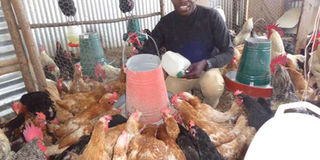Diary of a Poultry Farmer Don’t wait for infections, time to disease-proof your farm is now

A young poultry farmer, Antonio Mudongi, attends to his flock in Kitengela, Kajiado County. FILE PHOTO | NATION MEDIA GROUP
What you need to know:
- Biosecurity is a set of measures designed to protect a property from the entry and spread of pests, diseases and weeds.
- You see, a footbath is a pit measuring about 90cm long, 60cm wide and 10cm deep made of ordinary and waterproof cement mixed with sand and ballast.
- New birds present a greater risk to biosecurity because of their unknown disease status or if they are healthy carriers.
- Wash your hands after handling birds in isolation or birds of different groups and disinfect drinkers and feeders on a regular basis, preferably daily.
“The mason has completed building the footbaths, the one at the main entrance to the coop and the five at the entry to each chicken room,” Cleophas, my farm manager texted me.
“What about the one at the gate to the main compound where vehicles enter?” I asked and he replied in the negative.
“Do you know the total budget, including labour and materials?” I enquired further and he revealed it would cost me Sh12,500.
You see, a footbath is a pit measuring about 90cm long, 60cm wide and 10cm deep made of ordinary and waterproof cement mixed with sand and ballast.
You need a footbath at every entrance on the farm.
If you recall, a few weeks ago when I had an outbreak of infectious coryza and mycoplasma that wiped out close to 200 birds, one of the things Dr Mugachia of Gardenvet recommended was for me to improve biosecurity.
Biosecurity is a set of measures designed to protect a property from the entry and spread of pests, diseases and weeds.
“It is the cheapest, most effective means of disease control. No disease prevention programme can work without it,” the veterinary surgeon told me.
For me, I thought that vaccinating the birds regularly against common infections like Newcastle disease, fowl pox, fowl cholera and gumboro was enough.
“That is alright but in addition, biosecurity is designed to complement other measures. It is accomplished by maintaining the facility in such a way that there is minimal traffic of biological organisms like viruses, bacteria and rodents into the farm and chicken houses,” he explained.
“Isn’t the basin with a disinfectant and wood shavings that the workers are required to dip in their shoes before entering the coop adequate?” I enquired.
“That is not enough,” he said, “The worker should wear gloves, overall and gumboots so that he can disinfect the feet up to the ankle.”
SPREAD OF INFECTIOUS POULTRY DISEASES
I conducted my own research and found there are many ways infectious diseases can spread from farm to farm.
They include introduction of diseased birds or healthy carriers, shoes and clothing of visitors or workers who move from room to room, carcasses of dead birds that have not been disposed properly and contaminated feeders and drinkers.
In addition, rodents, free-flying birds and insects, contaminated delivery trucks and vehicles, contaminated feed and feed bugs and airborne fomites also spread diseases.
“How much biosecurity do I need?” I asked the good vet.
“Of all the possible breakdowns in biosecurity, the introduction of new birds, and traffic flow will probably cause you the most trouble.”
He explained that new birds present a greater risk to biosecurity because of their unknown disease status or if they are healthy carriers.
“Birds of different ages or those brought to the farm at different times should not be mixed for at least three to four weeks to confirm they are healthy.”
Further, he said that to work well, three biosecurity principles must be observed at all times: isolation, traffic control and sanitation.
The first measure – isolation – is about confining livestock within a coop or fence, separating birds by age group and practising an all-in, all-out approach which allows simultaneous de-population of facilities between flocks to enable time for periodic clean-up and disinfection to break the cycle of disease.
The second principle, traffic control, includes both the traffic onto your farm and the traffic patterns within the farm.
In addition to creating a resident bird area separate from the isolation area for keeping sick birds, use footbaths to disinfect footwear every time you enter the coop area.
CONTROLLING THE DISEASES
Also, establish a “clear zone” free of vegetation around buildings to discourage rodent and insect traffic into the buildings or pens.
The third principle, sanitation, addresses the disinfection of materials, people and equipment entering the farm and the cleanliness of the personnel on the farm.
Wash your hands after handling birds in isolation or birds of different groups and disinfect drinkers and feeders on a regular basis, preferably daily.
Dr Mugachia advised me to carry out a periodic clean-out, clean-up and disinfection of houses and equipment, at least once a year, including rodent and pest control procedures.
“Remember that drying and sunlight are very effective in killing many disease-causing organisms,” he said, adding dead birds should be disposed promptly by burning, burying, composting or sending them to a sanitary landfill.
All said, I am happy I have now moved a step forward because my farm has the footbaths, which contain a chemical called Kerol Germicidal mixed a table spoon in 10 litres of water.
The solution is used in the footbaths for two weeks maximum.
Further, I have developed a simple checklist which the farm manager has to go through every morning and tick against each to ensure my chickens are free of diseases.
However, success will only depend on whether he implements these measures to the letter.





